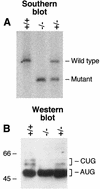Mice lacking the 68-amino-acid, mammal-specific N-terminal extension of WT1 develop normally and are fertile
- PMID: 12640141
- PMCID: PMC150738
- DOI: 10.1128/MCB.23.7.2608-2613.2003
Mice lacking the 68-amino-acid, mammal-specific N-terminal extension of WT1 develop normally and are fertile
Abstract
Mutations in the Wilms' tumor 1 gene, WT1, cause pediatric nephroblastoma and the severe genitourinary disorders of Frasier and Denys-Drash syndromes. High levels of WT1 expression are found in the developing kidney, uterus, and testis--consistent with this finding, the WT1 knockout mouse demonstrates that WT1 is essential for normal genitourinary development. The WT1 gene encodes multiple isoforms of a zinc finger-containing protein by a combination of alternative splicing and alternative translation initiation. The use of an upstream, alternative CUG translation initiation codon specific to mammals results in the production of WT1 protein isoforms with a 68-amino-acid N-terminal extension. To determine the function in vivo of mammal-specific WT1 isoforms containing this extension, gene targeting was employed to introduce a subtle mutation into the WT1 gene. Homozygous mutant mice show a specific absence of the CUG-initiated WT1 isoforms yet develop normally to adulthood and are fertile. Detailed histological analysis revealed normal development of the genitourinary system.
Figures




References
-
- Armstrong, J. F., K. Pritchard-Jones, W. A. Bickmore, N. D. Hastie, and J. B. Bard. 1993. The expression of the Wilms' tumour gene, WT1, in the developing mammalian embryo. Mech. Dev. 40:85-97. - PubMed
-
- Barbaux, S., P. Niaudet, M. C. Gubler, J. P. Grunfeld, F. Jaubert, F. Kuttenn, C. N. Fekente, T. N. Souleyreau, E. Thibaud, M. Fellous, and K. McElreavey. 1997. Donor splice site mutations in WT1 are responsible for Frasier syndrome. Nat. Genet. 17:467-470. - PubMed
-
- Bruening, W., and J. Pelletier. 1996. A non-AUG translation initiation event generates novel WT1 isoforms. J. Biol. Chem. 271:8646-8654. - PubMed
-
- Call, K. M., T. Glaser, C. Y. Ito, A. J. Buckler, J. Pelletier, D. A. Haber, E. A. Rose, A. Kral, H. Yeger, and W. H. Lewis. 1990. Isolation and characterization of a zinc finger polypeptide gene at the human chromosome 11 Wilms' tumor locus. Cell 60:509-520. - PubMed
-
- Dorin, J. R., P. Dickinson, E. W. Alton, S. N. Smith, D. M. Geddes, B. J. Stevenson, W. L. Kimber, S. Fleming, A. R. Clarke, M. L. Hooper, et al. 1992. Cystic fibrosis in the mouse by targeted-insertional mutagenesis. Nature 359:211-215. - PubMed
Publication types
MeSH terms
Substances
LinkOut - more resources
Full Text Sources
Molecular Biology Databases
